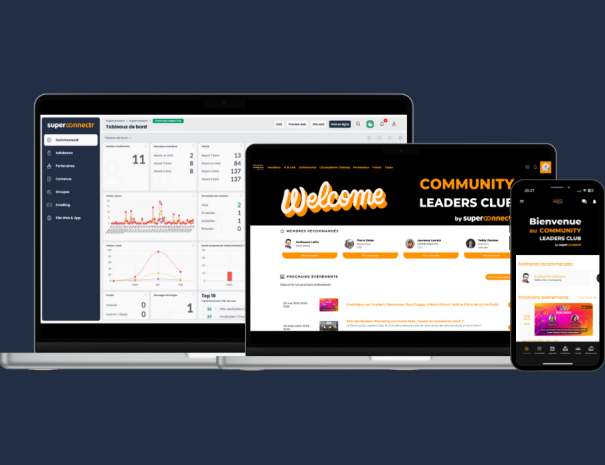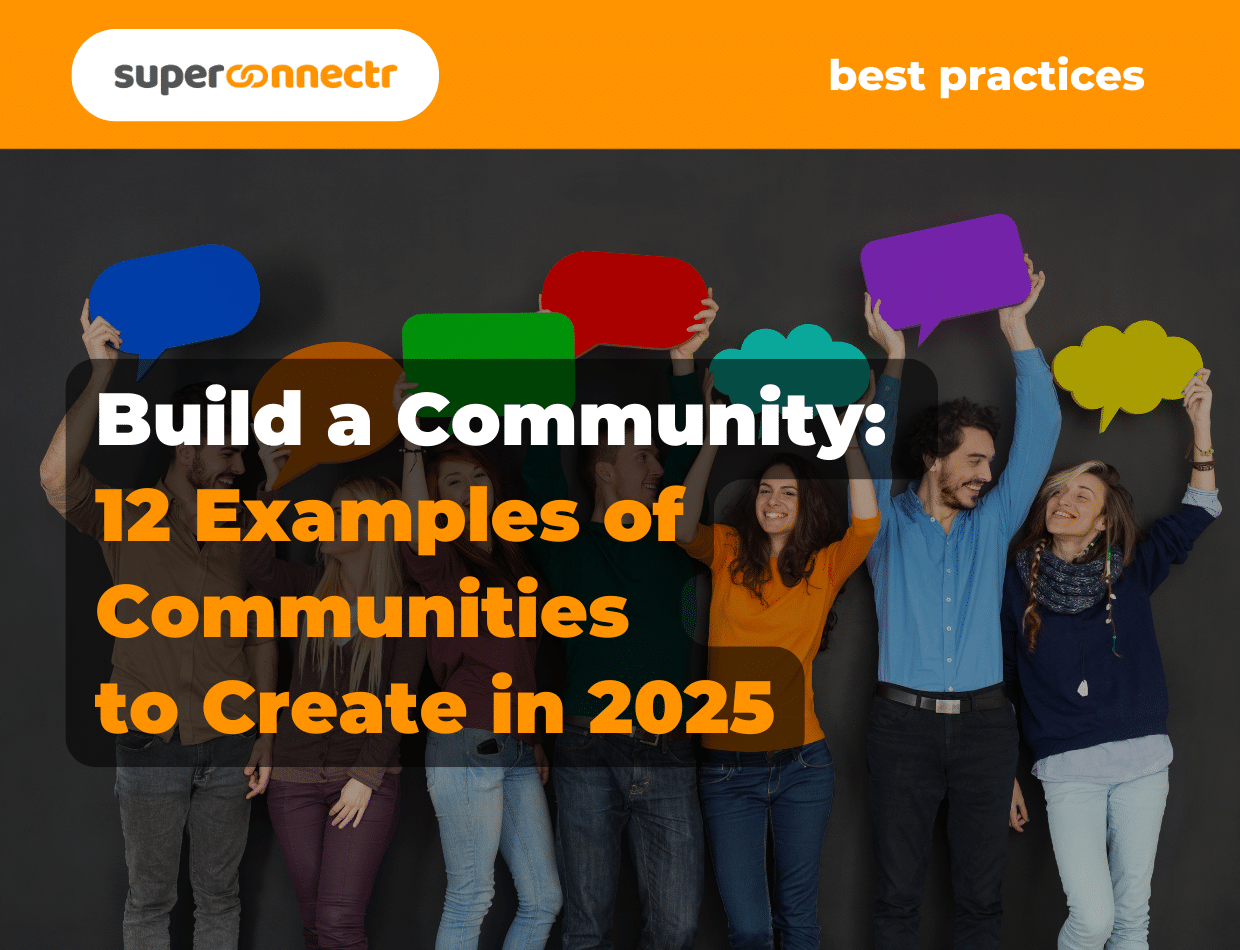Creating a community has become much more than a marketing trend: it's a strategic lever for all companies and associations wishing to strengthen loyalty, develop commitment, co-construct with their audiences and federate players around a common mission.
But what exactly do we mean by "creating a community"? How do you distinguish it from an "audience"? And, above all, where do we start?
Whether you're a company, a brand, an association, a business network, a competitive cluster or a training structure, the challenges are often the same: federating, structuring, leading and sustaining a collective dynamic.
This is why we often speak of "building a community", and why a new profession has been created in recent years: that of "Community Builder".
In this comprehensive guide, we cover :
The fundamental difference between audience and community
Visit different types of communities customers, members, partners, learners, collaborators, franchisees, etc.
Visit key steps to creating a community objectives, mission, animation, first ambassadors...
Whether you want create a BtoB, association, brand or regional communitythis guide will help you lay the foundations for a successful creating a community.
Audience or community: what's the difference?
Creating a community begins by making a clear distinction between a concept that is often confused: the audience. For although these two terms designate groups of people linked to an organization, they refer to radically different logics.

The audience: passive, punctual, disembodied
A audience refers to a group of individuals exposed to a content or brand. It can be large, occasional or volatile.
On social networks, an audience is measured in followers, impressions or views. But these indicators say nothing about real engagement, or the quality of the relationship.
Audiences are by nature transmitter-centric The brand communicates, the audience receives.
The link is often unidirectional, and audience involvement remains limited. They may consume, like or comment... but rarely contribute actively or forge links with other members.
The community: active, sustainable, involved
A community is based on a logic of relationshipof share and active participation. It involves people gathered around a common interest, a mission, or a collective experience. Its members are not simply exposed to a brand: they are part of it.
A community creates horizontal link between its members. Everyone can speak up, share their experiences, respond to a peer, recommend a good practice or a person.
The organization is no longer the only sender: it becomes the facilitator, the animator, the host of this collective dynamic. The community acts as a trusted third party.
The community is also part of the long time. It evolves, changes and grows with its members. It is not a channel, but a a living, interconnected space.
Why create an engaged community rather than accumulate followers?
Many organizations still confuse visibility with engagement. By extension, there is confusion between "audience" and "community".
However, a wide audience is not necessarily a loyal community. You can have 50,000 subscribers and zero real interaction. Conversely, a community of 500 active members can generate dozens of contributions, ideas and recommendations every week.
Creating a communityis to choose relational value rather than raw reach (mass). It means investing in depth of connection instead of chasing ephemeral virality.
It means banking onlasting commitment, l'collective intelligence and co-construction rather than simply pushing content.
In short, an audience look at. A community participate. An audience follows. A community act.
And in a world where loyalty, differentiation and activation are key, it's community that makes the difference.
What are the different types of community?
Creating a communityAbove all, it's about creating a space of trust where people share a common identity, mission, interests or goals.
But not all communities are alike. Here's an overview of the main types of community you can create, depending on the nature of your organization.

Create a customer community (BtoB or BtoC)
Creating a customer community for your company, is to create a space where your customers can be valued, be the first to know about your news, exchange ideas, ask questions, share feedback, recommend your solution or even co-create products and services with you.
For a BtoB communityThis often promotes information about the company's products and services, training, peer support, loyalty development and product improvement.
For a BtoC communityThis can take the form of enthusiast groups, ambassadors, advanced users or VIP clubs.
A community platform for your BtoB or BtoC customer communityThis is an essential tool for managing and promoting your brand.
Key benefits of a customer community :
Strengthen loyalty and retention by involving customers in an exchange space.
Encourage peer-to-peer support and reduce pressure on customer service.
Gather valuable feedback to improve products or services.
Creating a brand community
Visit brand community brings together people who share a common strong adherence to a brand's universe, values and image. It often goes beyond the simple framework of consumption to create a veritable sense of belonging.
It can include customers, prospects, ambassadors, fans or influencers.
It strengthens brand identification and amplifies its influence, in particular through branded platform to animate your community.
Key benefits of a brand community :
Strengthen brand identification, sense of belonging and market differentiation.
Amplify visibility through spontaneous recommendations and word-of-mouth.
Create a strong and lasting emotional bond with brand ambassadors and committed fans.
Create a community of ambassadors or influencers
Members of a community of ambassadors or influencers are often advanced users, passionate customers or key influencers.
They represent the voice of your brand, participate in your campaigns and carry your message. Bringing them together in a dedicated community strengthens their commitment, the recognition they receive for their role, and their ability to spread the word about your brand.
Key benefits of a community of ambassadors or infuencers :
Create a solid bond of trust and increase the number of organic talks about your products or services.
Facilitate the co-creation of personalized content and offers.
Strengthen social proof and trust in your brand.
Create a community of partners (resellers, distributors, integrators)
Members of a community of ambassadors or influencers are often advanced users, passionate customers or key influencers.
They represent the voice of your brand, participate in your campaigns and carry your message. Bringing them together in a dedicated community strengthens their commitment, the recognition they receive for their role, and their ability to spread the word about your brand.
Key benefits of a community of ambassadors or infuencers :
Create a solid bond of trust and increase the number of organic talks about your products or services.
Facilitate the co-creation of personalized content and offers.
Strengthen social proof and trust in your brand.
Create a community of testers or beta users
Ideal for software publishers, startups or innovative brands, the community of testers or beta users helps improve the offer before it goes to market.
It involves users in the idea generation, creation and validation process.
Key benefits :
Build user loyalty and gather concrete feedback on the "user experience".
Involve customers in product innovation and iteration.
Fostering future adoption through co-construction.
Create a community of investors or strategic stakeholders
The community of investors or strategic stakeholders is particularly useful for growing structures, mission-driven companies and cooperatives.
This community makes it easier to involve shareholders or financial backers in the long-term vision of a company's development and news, while benefiting from proven consideration and recognition.
Key benefits :
Promote transparency and trust in governance.
Provide access to high-level strategic feedback.
Facilitate investor buy-in and involvement.
Create a community of members (associations, federations, unions, clusters, competitiveness clusters, etc.)
In associations, members are not simply members: they are often active contributors, project leaders or even representatives.
Visit community of members of an association or federation enables the exchange of information on the challenges facing the economic ecosystem, the industry or the profession in a given region, the sharing of best practices, and a stronger collective voice with public and private partners.
A community platform to help you managing your professional association becomes essential to facilitate member management and community animation from a single source.
Key benefits of a membership community for an association or federation :
Promote the exchange of best practices and skills development.
Provide feedback on needs in the field, to help guide local, regional, national and international initiatives.
Strengthen collective representation with partners and institutions.
Clusters (Numeum, Digital League...) or competitive clusters (Axelera, Tenerrdis...) are unique in that they bring together companies, research organizations, schools and institutions around a common goal. common sectoral or territorial issues.
A community platform becomes a collaborative platform to connect members, encourage cross-fertilization of innovation, structure collaborative projects, leverage local expertise, and steer the network's activities on an industry-wide scale.
Key benefits :
Stimulate inter-company and inter-organizational collaboration.
Accelerate shared innovation and structuring projects.
Promote the expertise and successes of members and the local ecosystem.
Inter-professional union networks (MEDEF, CPME, etc.) represent and defend collective interests by federating different branches and economic sectors with state and institutional authorities, but these networks also create cross-functional exchange dynamics.
Managing an inter-professional union community means enabling members to inform, debate, propose, mobilize and a shared vision. It also means providing tools for coordination between local, regional and national levels.
Key benefits of an inter-professional union community :
Promote the circulation of strategic information between members.
Unite around common positions and actions.
Create a foundation for solidarity and inter-sectoral sharing.
Create a business network community or business club
Often referred to as "business clubs" or "clubs d'affaires", the business networks bring together entrepreneurs, managers and decision-makers with the aim of develop their business thanks to the strength of the collective.
Creating a community as part of a business network is all about giving depth to encounters and building trust between its members to facilitate business referrals to extend exchanges, initiate synergies and foster a network spirit on a day-to-day basis, at physical events and via a community platform to facilitate the exchange of information. networking between its members.
An application for Business Club is often the best solution for facilitating communication and access to the network between members.
Key benefits of a business network community or business club :
Multiply business opportunities through regular exchanges and business recommendations.
Foster trust and local synergies between members.
Structure a team around events and relational rituals.
Create a community of volunteers or contributors
Used extensively by NGOs, associations and event groups, the volunteer community aims to coordinate people who give their time to a common project.
Targeted events help build long-term commitment and loyalty thanks to a strong mission which supports the association.
Key benefits :
Facilitate the organization of collaborative projects and field missions.
Create a lasting link with committed but non-employee profiles.
Publicly promote the collective's actions and impact.
Create a community of learners (training organization, school, alumni...)
Whether learners in initial training, continuing education or graduates, these learning communities facilitate mutual support, access to resources, peer mentoring, networking and alumni involvement.
They extend the value ofeducational experience long after the course has finished and become a veritable Attractiveness lever for future learners in joining a network of professionals.
A platform dedicated to a learning community for its training organization is ideal for engage during training and for build member loyalty when it's finished.
Key benefits of a community of learners for a training organization :
Stimulate mutual support and the sharing of teaching experiences.
Create a lasting bond between the institution and its former learners.
Enhance the attractiveness and reputation of the establishment.
Create an employee community (internal, CSR, corporate culture)
In an HR, CSR or internal transformation context, creating a employee community allows strengthen corporate culture, internal commitment and cross-functionality.
This encourages knowledge sharing and collective intelligence, and enables employees to become more involved and, why not, ambassadors for the organization. A internal communication platform or application is ideal for achieving these objectives.
Key benefits of an employee community :
Improve internal communication, cohesion and adherence to corporate values.
Encourage participative innovation and distributed leadership.
Create a cross-functional, inclusive channel for teams to express themselves.
Create a community for a network of franchisees or sites (multi-location)
Networks of sales outlets, boutiques, agencies or franchisees share the need for internal communication, harmonization, dissemination of best practices and a sense of belonging to the network.
A community of franchisees or multi-site networks via a platform and internal community application in the company's colors creating links despite geographical dispersionThe aim is to promote local success stories and create a unifying space for all network members.
Key benefits :
Harmonize practices and service levels between facilities.
Create a sense of belonging and recognition for the network.
Encourage internal communication, feedback on local initiatives and the pooling of know-how.
In short: choosing the right community model for a sustainable community
Creating a community is not limited to opening an online group or organizing a few events.
Creating a community is a real strategic project which requires a vision, a strong mission, and a detailed understanding of its audiences.
By clearly differentiating between "audience" and "community", choosing the right type of community to build and laying the right foundations, you maximize your chances of creating a sustainable community, a space that is engaging and useful for all its members.
In a future article, we'll look at how to switch from from choosing the type of community to creating and managing a communityDiscover how to identify and develop your ambassadors, industrialize your processes and effectively manage a community over the long term.
See you in our next article:
Building a community: 10 key steps.
FAQ (Frequently Asked Questions)
Why create a professional (BtoB) community?
Creating a community enables you to gather around you members who share the same issues, interests or values. It's a powerful lever for building loyalty, generating collective value and strengthening the sense of belonging to a project, association, company or network.
What's the difference between an audience and a community?
An audience is passive: it receives a message. A community is active: it interacts, exchanges and contributes. A community lives, evolves and builds a lasting bond of trust with your organization.
What type of community should I create for my business?
It all depends on your objectives:
Build customer loyalty: customer community
To unite your partners: ambassador community
To animate an economic or business network: business club or B2B community
To represent a collective : member community
To support learners or employees: internal or training community
The No. 1 challenge is always to clearly define the mission and the value provided.
Do I need a specific tool to manage my community?
Yes. Platforms like SuperConnectr are designed to save you time: a good community platform centralizes the management of members, the sending of emails, the publication of content, the organization of events, the connection and exchange between members, the collection of data, while guaranteeing complete customization to your image.
Is a mobile app really useful?
For professional use, yes. A mobile community application allows your members to stay connected, receive real-time notifications, register for events, consult content or exchange ideas, all in a fluid, colorful environment.
Discover the SuperConnectr community platform!
An all-in-one community platform, 100%, customized with your brand identity.
Give the members of your network a community web Platform and mobile App with your Brand to manage, engage and promote your community!



Leave a Reply